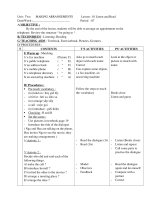e unit 2 networking infrastructure
Bạn đang xem bản rút gọn của tài liệu. Xem và tải ngay bản đầy đủ của tài liệu tại đây (881.61 KB, 17 trang )
<span class="text_page_counter">Trang 1</span><div class="page_container" data-page="1">
<b>ASSIGNMENT 1 FRONT SHEET</b>
<b>QualificationBTEC Level 5 HND Diploma in ComputingUnit number and title Unit 2: Networking Infrastructure</b><b>Student declaration</b>
I certify that the assignment submission is entirely my own work and I fully understand the consequences ofplagiarism. I understand that making a false declaration is a form of malpractice.
<b>Student’s signature</b>
</div><span class="text_page_counter">Trang 3</span><div class="page_container" data-page="3">1.A network consists of two or more computers that are linked in order to share resources(such as printers and CDs), exchange files, or allow electronic communications. Thecomputers on a network may be linked through cables, telephone lines, radio waves,satellites, or infrared light beams.
2. Types networking :
2.1: Local area network (LAN).A local area network, or LAN, is the most commonnetwork type. It allows users to connect within a short distance in a common area. Once theyconnect, users have access to the same resources
2.2: Metropolitan area network (MAN).A metropolitan area network, or a MAN, is amedium-sized network that's larger than a CAN. While a MAN is a costly network, itprovides efficient connectivity between devices across a wide geographical range
2.3:Wide area network (WAN). A wide area network, or a WAN, is an extensivenetwork that's not confined to geographical space. Corporations and international companiesmay use WANs to provide a common network with far-reaching connectivity.
3. Benefit of the network:Active networking is vital to career growth. Often confusedwith selling, networking is actually about building long-term relationships and a goodreputation over time. It involves meeting and getting to know people who you can assist, andwho can potentially help you in return.
4. Constraint of the network:A constraint network can be represented by a graphcalled a primal constraint graph or just a constraint graph, where each node represents avariable and the arcs connect all nodes whose variables are included in a constraint scope ofthe problem.
5. Evaluate the impact of current network technology, communication and standards:Improving the competitiveness of the 2000 century and shape of future developments in ICTso that the necessities of society and the global economy are met. ICT is at the very core ofthe knowledge-based society. Activities will continue to strengthen the world's scientific andtechnology base and ensure its global leadership in ICT, help drive and stimulate product,service and process innovation and creativity through ICT use and value creation in the worldand ensure that ICT progress is rapidly transformed into benefits for worldwide citizens,businesses, industry and governments. These activities will also help reduce the digital divideand social exclusion
Protocol and standards:A protocol defines a set of rules used by two or more parties tointeract between themselves. A standard is a formalized protocol accepted by most of theparties that implement it
List some protocols
Transmission Control Protocol (TCP):TCP is a popular communication protocol which isused for communicating over a network. It divides any message into a series of packets thatare sent from source to destination and there it gets reassembled at the destination.
Internet Protocol (IP):IP is designed explicitly as an addressing protocol. It is mostly usedwith TCP. The IP addresses in packets help in routing them through different nodes in anetwork until it reaches the destination system. TCP/IP is the most popular protocol
</div><span class="text_page_counter">Trang 4</span><div class="page_container" data-page="4">Transmission Control Protocol implemented primarily for creating loss-tolerating andlow-latency linking between different applications.
Post office Protocol (POP):POP3 is designed for receiving incoming Emails.
Simple mail transport Protocol (SMTP):SMTP is designed to send and distribute outgoingEMail.
File Transfer Protocol (FTP):FTP allows users to transfer files from one machine toanother. Types of files may include program files, multimedia files, text files, and documents,etc.
HyperText Transfer Protocol (HTTP):HTTP is designed for transferring a hypertext amongtwo or more systems. HTML tags are used for creating links. These links may be in any formlike text or images. HTTP is designed on Client-server principles which allow a client systemfor establishing a connection with the server machine for making a request. The serveracknowledges the request initiated by the client and responds accordingly.
P2. Network topology definition:Network topology refers to the manner in which the linksand nodes of a network are arranged to relate to each other. Topologies are categorized aseither physical network topology, which is the physical signal transmission medium, orlogical network topology, which refers to the manner in which data travels through thenetwork between devices, independent of physical connection of the devices
2.1 Definition :Physical network topology deals with the physical elements of yournetwork, such as cables, and connectors. On the other hand, logical network topologyprovides a virtual representation of how your network is arranged and how the componentsconnect with each other.
2.2 Communication and bandwidth :
<b>Throughput: Communication affects the throughput or the amount of data that can be</b>
transmitted over a network in a given time. Higher throughput is desirable for networks thathandle large amounts of data, such as video streaming or file sharing networks.
<b>● Latency: Communication can introduce latency or delay in data transmission.</b>
Latency can be affected by factors such as the distance between devices, the quality ofcommunication channels, and the processing time at each device.
<b>● Reliability: Communication reliability is crucial for ensuring that data is transmitted</b>
accurately and without errors. Reliable communication protocols, error detection, andcorrection mechanisms are essential for maintaining data integrity.
</div><span class="text_page_counter">Trang 5</span><div class="page_container" data-page="5">requirements on network performance can be observed in the following ways:
<b>● Data Transfer Speed: Higher bandwidth allows for faster data transfer speeds.</b>
Networks with high bandwidth can handle large amounts of data simultaneously,resulting in faster communication and reduced latency.
<b>● Congestion: Insufficient bandwidth can lead to network congestion, where the</b>
network becomes overloaded with data, causing delays and reduced performance.Bandwidth requirements should be carefully assessed to avoid congestion.
<b>● Quality of Service: Bandwidth requirements are crucial for determining the quality of</b>
service (QoS) provided by a network. Applications with high bandwidth
requirements, such as video conferencing or online gaming, may require dedicated orprioritized bandwidth to ensure a smooth user experience
P3 Discuss the operating principles of networking devices and severe types.3.1 Discuss 1 or 2 operating principles of a selected networking device .
3.2 List network devices : network switch, router, Gateway3.2.a : Network switch
A network switch connects devices within a network (often alocal area network, orLAN*) and forwardsdata packetsto and from those devices. Unlike arouter, a switch onlysends data to the single device it is intended for (which may be another switch, a router, or auser's computer), not to networks of multiple devices.
3.2.b : Router
A router is a device that connects two or more packet-switched networks orsubnetworks. It serves two primary functions: managing traffic between these networks byforwardingdata packetsto their intendedIP addresses, and allowing multiple devices to usethe same Internet connection.
3.2.c : Gateway
A router is a device that connects two or more packet-switched networks orsubnetworks. It serves two primary functions: managing traffic between these networks byforwardingdata packetsto their intendedIP addresses, and allowing multiple devices to usethe same Internet connection.
3.3 List server types :
<b>1. Web server</b>
An open-source web server is used for accessing the world wide web through public domainsoftware. These servers connect stored information from an internet website to your owncomputer. Web servers store information for the internet that is retrieved via "HTTP" codeand sent to your web browser. This is one of the most widely used types of server
</div><span class="text_page_counter">Trang 6</span><div class="page_container" data-page="6">Proxy servers act as a bridge between a host server and a client server. A proxy sends datafrom a website to your computer IP address after it passes through the proxy's server. Thispractice adds a layer of security since the information is requested then transferred from thesource to the proxy server and never directly from a client to another user. A proxy server canfilter out various harmful internet entities.
</div><span class="text_page_counter">Trang 7</span><div class="page_container" data-page="7">This allows users to bypass downloading data to their own hardware in order to accessapplications. Application servers can effectively host large amounts of application data tomany users at once, making them ideal for businesses.
<b>6. File server</b>
A file server stores data files for multiple users. They allow for faster data retrieval andsaving or writing files to a computer. This is a basic type of server used commonly byorganizations where lots of users need access to files that are more conveniently and safelystored on a server than a personal computer.
</div><span class="text_page_counter">Trang 8</span><div class="page_container" data-page="8">Database servers function as large storage spaces that organizations use and access to runmultiple programs to meet their needs. A database server can run independently of anydatabase architecture.
<b>8. Mail server</b>
A mail server stores and delivers mail for clients through email service platforms. Becausemail servers are set up to continually connect to a network, individual users can access theiremail without running any systems through their own device.
</div><span class="text_page_counter">Trang 9</span><div class="page_container" data-page="9"><b>4.1 Explain what is meant by interdependence</b>
Inter- means "between," so interdependence is dependence between things. We often useinterdependence to describe complex systems. Marriage creates a state of interdependencebetween spouses. If your dog provides you with love and happiness, and you provide yourdog with food and walks (and love and happiness), then your relationship with your dog isone of interdependence.
<b>4.2 What is a Workstation</b>
A workstation (WS) is a computer dedicated to a user or group of users engaged inbusiness or professional work. It includes one or more high resolution displays and a faster
</div><span class="text_page_counter">Trang 10</span><div class="page_container" data-page="10">workstation may also have a higher-speed graphics adapter and more connected peripherals.The term workstation also has been used to reference a PC or mainframe terminal on a localarea network (LAN). These workstations may share network resources with one or morelarge client computers and network servers
<b>Techopedia Explains Workstation</b>
Workstations usually are built with an optimized design for complex data manipulation andvisualization. Examples include image rendering and editing, computer-aided design (CAD),animations and mathematical plots. Workstations were the first industry segment to marketcollaboration tools and advanced accessories and enhancements. These include 3D mice,multiple displays and high performance/capacity data storage devices.
Eventually, mainstream PCs adopted workstation elements contributing to the decline of theworkstation market segment. Additionally, the cost differential decreased between lower-endworkstations and higher-end PCs. Low-end workstations used Intel Pentium 4 or AMDAthlon 64 CPUs, whereas high-end PCs used powerful processors such as the Intel Xeon,IBM Power, AMD Opteron or Sun UltraSPARC – a powerhouse for computer-processingwork. These latter machines are sometimes referred to as workstation class PCs and includefeatures such as:
● Error-correcting code (EEC) memory support● Additional memory sockets for registered modules● Multiple processor sockets for more powerful CPUs● Multiple displays
● Reliable operating systems (OSs) with advanced features● High-performance graphics cards
</div><span class="text_page_counter">Trang 11</span><div class="page_container" data-page="11">microprocessors and Windows, Mac OS X, Solaris 10 and Linux-distributed operatingsystems
<b>4.3 What is a Network software</b>
Network software is a fundamental element for any networking system. It helpsadministrators and security personnel reduce network complexities, and manage,monitor, and better control network traffic. Network software plays a crucial role inmanaging a network infrastructure and simplifying IT operations by facilitatingcommunication, security, content, and data sharing.Network software offers usefulbenefits to organizations. It has become an important tool in facilitatinground-the-clock communication and allowing an uninterrupted exchange ofinformation. One of the most significant advantages of network software is its directcorrelation with productivity. The centralized nature of network software increases theproductivity of the complete system. This helps reduce end-user technical supportproblems.For example, if an end user accidentally damages their computer, thechances of losing data are reduced substantially as all its data is already shared on thenetwork. Another key benefit of network software is its ability to enable
programmatic management of network resources. This eliminates the need for manualprocesses, thereby providing a dynamic and efficient network configuration to workwith.
</div><span class="text_page_counter">Trang 12</span><div class="page_container" data-page="12">network. This is particularly useful when hiring or relieving
<b>File management lets administrators decide the location of data storage and</b>
control user access to that data.
<b>Access enables users to enjoy uninterrupted access to network resources.Network security systems assist administrators in looking after security and</b>
preventing data breaches.
Although, it is important to note that traditional networks were hardware-basedand comprised elements such as routers and switches with embedded software. Thedecoupling of software from hardware, called software-defined networking (SDN),works exceptionally well to simplify the management of infrastructure, making itmore adaptable to the constantly evolving course of the tech world. The introductionof SDN has been a turning point and has completely changed the way networking isdone.
<b>Types of Network Software</b>
There are numerous types of network software available, with most of them beingcategorized under the communications and security arena. The varieties of networksoftware differ based on their key features and costs. The main role of networksoftware is to eliminate the dependence on hardware by streamlining communicationsacross multiple devices, locations, and systems. Not only are they extremely usefulfor end-user hardware (laptops, desktops), the addition of software is bound to have apositive effect on the organization’s everyday functioning and operations.
</div><span class="text_page_counter">Trang 13</span><div class="page_container" data-page="13">In many ways, data within networks is like a child. With time, it only grows, and as itdoes, it requires adequate attention. Soon enough, data needs to be stored spanningmultiple locations and a wide range of devices. Network storage software allowsbusinesses to utilize a standard interface that manages countless databases betweenusers or clients. It serves as a good manager of access between various departments oressential communities within an organization. This way, anybody having access canview or retrieve information with just a click, and at the same time, security concernsare also taken care of.
<b>2. Data archiving software</b>
In today’s day and age of dynamic networks spread across various functioningcorporate entities, data once misplaced is data lost. Hence, it is vital to take regularbackups. As organizations grow and networks evolve in size, it gets especially trickyto save data appropriately. In addition to that, data that needs to be stored increases ata rapid pace, and its management gets costlier. In such a situation, data archivingsoftware is a perfect choice.
Organizations have heaps of data that might not have to be utilized daily but is stillessential to be stored for various purposes, one of them being for regular compliance.Data archiving software enables better management of such information and is an
</div>








